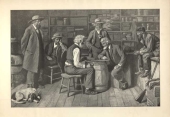The Checker Maven
The World's Most Widely Read Checkers and Draughts Publication
Bob Newell, Editor-in-Chief
Published every Saturday morning in Honolulu, Hawai`i
Noticing missing images? An explanation is here.
An Historical Game

In today's entry in our Checker School series, drawn from Ben Boland's celebrated Famous Positions in the Game of Checkers, Mr. Boland is unusually laconic and we had to spend a few minutes divining the reason he titled the study below "An Historical Game." You'll understand it better after you try the problem and then view the solution and notes.
BLACK

WHITE
Black Plays; White Draws
W:WK8,21,25,K26:B13,18,K19,28.
Forces are even (Black is about to get a second king), but in checkers we know that's only half the story. Black has superior mobility and that often means victory. It looks like White is going to have an historic struggle here just to pull out a draw.
Can you make personal history by solving the problem, or will you just be history? It's not something to become "historical" over; give it your best try and then click on Read More to see the solution and all the trimmings.![]()
Now You Dunne It

We think the poor fellow in the cartoon above is going to be in a lot of trouble in very short order. We only hope that he can somehow win the situation, but that's going to be quite a challenge.
Another kind of win that's a real challenge occurs in our game of checkers (although we'll bet it's easier than the situation depicted in the cartoon). It's known as Dunne's Win and it will be explained to us by Willie Ryan, as we quote from his classic Tricks Traps & Shots of the Checkerboard.
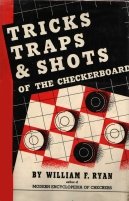
"Similar to the difficult George Dick Gambit, the ever practical Dunne's Win is a delicately balanced positional win that white is required to engineer by precise play.
Here's the run-up: 9-14, 22-17, 11-16, 25-22, 8-11, 22-18, 16-20, 18-9, 5-14, 29-25, 4-8---A, and we have the position depicted on the diagram, known as 'Dunne's Win.'

WHITE
White to Play and Win
W:W32,31,30,28,27,26,25,24,23,21,17:B20,14,12,11,10,8,7,6,3,2,1.
A---Black's position is hopeless after this move, with 22 pieces still on the board. The correct procedure is 11-15*, 25-22, 7-11*; now either 17-13 or 24-19 taxes black. For continuation, see Reisman's Pioneer Book, the leading authority on this formation."
Can you do this problem, or will you get Dunne on? When you Dunne done it, click on Read More to see the solution and notes.![]()
Fast Relief

At the time of writing, much of the United States mainland was suffering from unseasonable heat, and the hottest month of the year, August, still lays ahead. We can only hope that our mainland friends get some fast relief.
Fast relief is also the subject of this month's speed problem. As you'll see when you click on the link below, with correct play Black can win quickly and head off to a refreshing shower or a tall, cool beverage ... if the right moves are made. We rate this problem as "easy to medium" and we'll give you a generous 15 seconds to find the win and earn your reward. When you've solved it, come back here and click on Read More to check your solution.
August Speed Problem (easy to medium, 15 seconds)
![]()
Double Duty

Checker players can take an important lesson from working moms, who do double duty--- they are full-time employees as well as full-time mothers and homemakers. We often wonder how they have the mental and physical stamina to do it all.
You might think the point we're making is that, as checkerists, we can ourselves do "double duty" and fit checker study and play into our busy lives (admittedly, much less of a task than that faced by working moms). While a valid point, that's not where we're going in today's column. You'll get the idea when you solve the problem diagrammed below.
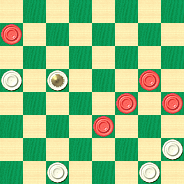
WHITE
White to Play and Win
W:W32,30,28,K14,13:B23,20,19,16,5.
Can you find the White win right away, or will you have to double back and try again? Make at least two attempts before you click on Read More (and that's a single click, not a double click) to see the solution.![]()
McCulloch's Masterpiece

There was a huge ranch recently for sale in McCulloch County, Texas. The sales literature called the 8,000 acre ranch a "masterpiece" and attached the same label to the property's 7500 square foot ranch home. Priced at just over 25 million dollars, we're reminded that this version of "McCulloch's Masterpiece" won't come cheap, though we have little doubt that it's worth every cent.
For better or worse, The Checker Maven doesn't have a budget that supports such high end investments; at times we have enough trouble just paying the bills. So today, we'll bring you a different "McCulloch's Masterpiece," one of the checker variety, and one that won't cost us--- or you--- anything at all. It's the latest entry in our Checker School series, and comes from Ben Boland's Famous Positions in the Game of Checkers.
WHITE
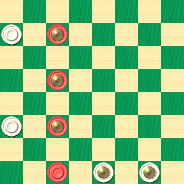
BLACK
Black to Play and Win
B:W28,12,K2,K1:BK27,K19,K11,3.
Don't bet the bank on this one, just enjoy solving it! When you've found the answer, click on Read More to cash in on the solution, three sample games, and detailed explanatory notes.![]()
Dick's Gambit

The photo above is of an iceboat named Dick's Gambit. It was taken by Michigan photographer Rick Wolanin, and is used with his kind permission. (You can see more of his work here.)
We can understand why the boat bears the "Gambit" moniker; ice-boating is a pretty wild and wooly endeavor. After all, a "gambit" is a deliberate risk taken in the hope of gaining something in return.
There are gambits in checkers, too; there is even "Dick's Gambit" although in this case we refer to checkerist George Dick. Willie Ryan featured Mr. Dick's gambit in Tricks Traps & Shots of the Checkerboard, and we're reprinting Willie's words for you today.

"As a general rule, an early losing move, when properly met, causes the game to deteriorate rapidly. The numerous early losses illustrated in this book prove that. However, there are some exceptions to this rule, as in the game below, where white makes a losing move on the eighth turn, yet is able to keep the game going for a long time, on the very fringe of tenability, only to succumb in the end to black's exacting play.
| 11-15 | 5-9 | 11-16 |
| 24-19 | 25-22---A | 18-15---E |
| 15-24 | 8-11 | 10-19 |
| 28-19 | 30-25---B, C | 22-17---F. |
| 9-14 | 12-16*---D | See the |
| 22-18 | 19-12 | diagram. |
A---A losing move---1. Although white is lost on the eighth play, with 22 pieces still on the board, this is one case where you can't count your checkers until they're hatched. The usual continuation for a draw at A is 26-22*, 8-11, 22-17, 11-16, 25-22, 16-20, 17-13, 4-8, 22-17, 8-11, 30-26, 11-15, 18-11, 7-16, 26-22, 2-7, 22-18, 7-11, 18-15, 11-18, 29-25, 3-8, 31-26, 8-11, 19-15, 10-19, 17-10, 6-15, 13-6, 1-10, 23-7, 15-18, 7-3, 19-23, 26-19, 16-23, 3-8, 11-16, 8-11, 16-19. James Hill.
B---If 22-17 is played at this point, black scores with: 9-13, 18-9, 13-22, 26-17, 6-22, 30-26, 11-15, 26-17, 15-24, 27-20, 10-15, 29-25, 15-19, 23-16, 12-19, 31-26, 4-8, 25-22, 8-11, etc. John Drummond.
C---If 27-24 is played, the win is clinched by black with: 11-16, 24-20, 3-8, 20-11, 8-24, 32-28, 4-8, 28-19, 8-11, 30-25, 1-5, 22-17, 9-13, 18-9, 5-14*, 25-22, 11-15, 19-16, 12-19, 23-16, 7-11, 16-7, 2-11, 26-23, 11-16. Wm. F. Ryan.
D---The only move to force the win, which proves that sometimes you must give a man to get a game.
E---Absolutely necessary, as black is threatening to win with 16-19.
F---Again forced, as 22-18 is suicide if black moves 16-20 in reply; while 32-28, 4-8, 22-17, 7-10, reverts to Note H."
1---A very long computer analysis says that this move is clearly inferior, but it's hard to interpret it as a dead loss at this point. It's interesting to watch the computer, as the analysis runs deeper and deeper, slowly increase its evaluation of Black's advantage, but after over half an hour, it still doesn't see a definite win---Ed.
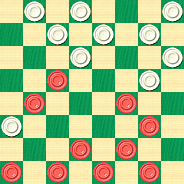
BLACK
Black fo Play and Win
B:W32,31,29,27,26,25,23,21,17,12:B19,16,14,9,7,6,4,3,2,1.
Solving this problem won't require a gambit on your part, or even a slippery ice-boat ride; all that's needed is substantive checker skill. Give it a try and then slide your mouse to Read More to see the solution.![]()
All But One

It's the sort of thing we did when we were kids. We'd find a plate of cookies on the kitchen table, and we'd eat all but one, thinking that if we left that one cookie behind, no one would think that we had eaten the rest. Somehow, it never seemed to work, but that didn't stop us from trying ... and those cookies were so good!
We've titled today's stroke problem "All But One" and you'll know why we chose that title when you find the solution.
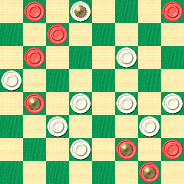
WHITE
White to Play and Win
W:W26,24,22,20,19,18,13,11,K2:BK32,28,K27,K17,9,6,4,1.
Can you solve this one or will you get caught with your hand in the cookie jar? It's an elegant composition and the solution is a treat ... perhaps even as good as those cookies we purloined all those many years ago. When you've eaten this problem up, click on Read More to see the solution.![]()
![]()
A Grand Rapids 4th

Once again, we take the annual opportunity to remark that as unabashed and unapologetic patriots we greatly enjoy celebrating the 4th of July holiday. For us, that celebration always includes the publication of a fine checker problem by an American composer.
A little while back, we discovered the astonishing work of late 19th century checkerist O. H. Richmond, of Grand Rapids, Michigan (an all-American town if there ever was one, as the photo above illustrates). Today we're pleased to present another of Mr. Richmond's fine problems with the hope that you will enjoy it as much as we did.

WHITE
White to Play and Win
W:W5,21,30,31:B6,9,K13,28.
Join us in including checkers in your 4th of July festivities. Solve the problem, and then click on Read More to see the solution.![]()
An Evening's Study

Study is usually a good thing; it's often an important part of the road to success in many an endeavor, checkers not the least among them. Sometimes, though, it gets a little overwhelming, and we sympathize with the poor student shown above, who seems to have gone into something like "study meltdown."
As today's entry in our Checker School series, we present a problem that the great checker writer Ben Boland called An Evening's Study. We suspect that there's enough material here for much more than a single evening, and we advise you to avoid the fate of our hapless student. Take your time and enjoy rather than trying to cram it all in at once.
BLACK
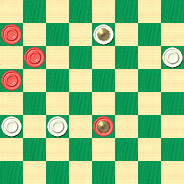
WHITE
White to Play and Win
W:W22,21,12,K7:BK23,13,9,5.
Will you be an "A" student on this one, or will your grade be somewhat lower? It's up to you; put in your study time and then click on Read More to see the solution, sample games, and detailed study notes.![]()
The Jaques Shot

We've all heard the well-known French children's song Frere Jaques, but we'll guess that relatively few of us are familiar with its origins and possible meanings. Frere Jaques is usually translated as "Brother John," but "brother" can refer to a monk as well as a sibling. In fact, there's some evidence that Frere Jaques is related to Girolamo Frescobaldi's Fra Jacopino, lending credence to the "monk" theory.
We don't think Fra Jacopino, or Frere Jaques for that matter, were checker players, though perhaps they knew of an older version of the game. In any case, the subject of today's column, a different Jaques, was certainly a checkerist. Willie Ryan, in his seminal work Tricks Traps & Shots of the Checkerboard, gives us the scoop.

"One of the prettiest of all strokes is the much heralded Jacques Shot. E. Jacques, of Canada, used it for the first time in defeating a player by the name of Campbell, first name unknown. Invariably, writers have used the order of moves played in the Campbell-Jacques game to illustrate the stroke, but as explained in my note B, this invalidates the scientific value of the coup. It is neither practical nor advisable to make a losing move to bait a trap. Any experienced player knows better than to take such a risk. In my treatment of the Jacques stroke, the correct order of moves is given so that white can play for the shot without making a losing move at any point.
| 9-13 | 11-16 | 13-17 |
| 24-19 | 25-21 | 31-26---3 |
| 11-16 | 6-9 | 9-13---4 |
| 22-18 | 23-18 | 25-22 |
| 8-11 | 16-23 | 12-16 |
| 28-24 | 26-19 | 15-10 |
| 16-20 | 4-8---A | 2-7---C. |
| 18-14 | 29-25 | Now see the |
| 10-17 | 7-11---B | diagram. |
| 21-14 | 19-15 |

WHITE
White to Play and Win
W:W32,30,27,26,24,22,21,18,14,10:B20,17,16,13,11,8,7,5,3,1.
A---The following is much stronger---1, and almost makes the run-up on the Jacques Shot untenable: 13-17, 18-15* (the only move to draw), 9-18, 21-14, 18-22, 30-25*, 7-10, 14-7*, 2-18, 27-23*, 18-27 (20-27, 23-14, 22-26, 32-23, 26-30, 25-21, 1-6, 23-18, a draw), 25-18, 5-9, 32-23, 20-27, 31-24, 9-13, 19-15, 13-17, 18-14, 17-22, 14-10, 22-26, 23-19, 4-8, 24-20*, 26-31, 20-16, 31-27, 29-25*, 27-24 (27-23, 25-22*, 23-27, 10-6*, a draw), 16-11, 24-20, 11-4, 20-16, 4-8, 16-23, 15-11, 12-16, 8-12, etc.; a draw. Wm. F. Ryan.
B---If 8-11 is played here, then white's only move to draw is 25-22*---2. In the historical Campbell-Jacques game, 13-17 was played; white (Jacques) replied with 31-26, which loses for black by: 8-11, 32-28 (25-22, 11-15, black wins), 17-22, 26-17, 11-15, 19-10, 9-13, 25-22, 5-9, 14-5, 7-32, 24-19, 32-27, etc. F. F. Smith, Birmingham, England. However, if after 13-17 at B, white replies with: 18-15, 9-18, 21-14, a draw by black will be difficult. Hence, to reach the Jacques Shot scientifically without either side making a losing move, 7-11 must be played before 13-17, as the latter move virtually loses at this point.
C---The losing move, and it forms the great Jacques Stroke. Although this classical 12-piece clearance has been essayed and acclaimed by 1001 writers on the game, not one has ever attempted to show black's losing move, nor has any authority ever published the play leading up to the shot in the proper scientific sequence. This is not unlike a musician with rheumatic fingers trying to do justice to a fine rhapsody on a rusty instrument that is out of tune. My examination of the situation shows that instead of 2-7 at C, black can effect the following beautiful draw, two pieces short: 16-19*!, 24-15, 2-7*, 27-24, 20-27, 32-23, 5-9, 14-5, 7-14, 18-9, 11-27, 21-14, 3-7*!, 26-23, 27-31, 23-19, 13-17*!, 22-13, 8-11, 30-25, 31-27, 25-21, 27-23, 21-17, 23-16, 9-6, 1-10, 5-1, 16-12, 13-9, 10-15, 1-6, 11-16. Wm. F. Ryan. This draw is almost as good as the shot!"
1---The computer doesn't see any real difference between the two moves---Ed.
2---The computer gives 32-28 to draw and sees 25-22 as a possible White loss---Ed.
3---A probable loss for White; 30-26 was required here. We're a little surprised Willie missed this---Ed.
4---But Black gives away all the advantage. 11-16 likely would have won---Ed.
You don't need to be a monk, speak French or Italian, or be familiar with musical history to solve the problem diagrammed above. You do need to be a pretty good checker player, though. When you've found la solution (or should that be la soluzione?) click your mouse on Read More to check your work.![]()
The Checker Maven is produced at editorial offices in Honolulu, Hawai`i, as a completely non-commercial public service from which no income is obtained or sought. Original material is Copyright © 2004-2025 Avi Gobbler Publishing. Other material is public domain, AI generated, as attributed, or licensed under CC1, CC2,CC3 or CC4. Information presented on this site is offered as-is, at no cost, and bears no express or implied warranty as to accuracy or usability. You agree that you use such information entirely at your own risk. No liabilities of any kind under any legal theory whatsoever are accepted. The Checker Maven is dedicated to the memory of Mr. Bob Newell, Sr.

